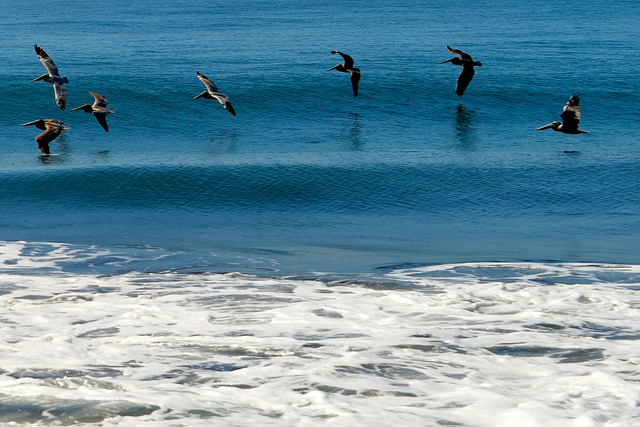
Pelicans at Monterrico, Guatemala. Photo © David Amsler, licensed Creative Commons Attribution.
Guatemala’s identity as a mostly mountainous country of cool lakes, evergreen forests, and wandering rivers has meant the coasts (Caribbean and Pacific) have traditionally been omitted from the collective consciousness in favor of its better-known, more traditional attractions. Very few of the Pacific Coast’s black-sand beaches are inhabited, the chief economic activities along the seaboard being fishing, shrimp farming, and loofah production. The actual sand beaches are separated, along much of the coast, from mainland Guatemala by a narrow channel known as the Canal de Chiquimulilla, running the length of the coast from the town of Sipacate east to Las Lisas, near the Salvadoran border, traversing Puerto San José, Iztapa, and Monterrico along the way. Things have started to change in recent years with the growth of Guatemala’s tourism industry, as visitors and foreign residents seek new places to explore beyond the well-trod path.Things have started to change in recent years with the growth of Guatemala’s tourism industry, as visitors and foreign residents seek new places to explore beyond the well-trod path. The Pacific port of San José has always been popular with Guatemala City residents as a place for sun and surf, though foreign visitors will find more acceptable places to visit elsewhere along the Pacific seaboard; it’s just 90 minutes from the capital via a four-lane toll road. Adjacent to Puerto San José is the newer Puerto Quetzal, best known for its cruise ship terminal hosting an increasing number of seafaring visitors to Guatemala. The Pacific Coast plains are bisected by Highway CA-2, which runs west to east from the Mexican border all the way to El Salvador.The beaches found in and around the area of Monterrico and its namesake sea turtle preserve have become the site of vacation homes and resort hotels. Nestled in between these two poles lies Iztapa, Guatemala’s original colonial seaport, which in recent years has gained notoriety as word gets out about the world-class sailfishing in Guatemala’s Pacific waters.

Pacific Coast
Guatemala is also Central America’s surfing frontier, with some excellent breaks on many of the coast’s empty beaches, particularly around the village of Sipacate and farther west toward Mexico. Things get more primitive the farther west you head from Sipacate, though the port of Champerico might soon become a magnet for tourism investment. Champerico is a satellite of nearby Retalhuleu, a haunt of the Pacific Coast’s farming and ranching community and now the site of the large-scale Xocomil and Xetulul amusement parks that are collectively Guatemala’s most-visited tourist attraction. Other nearby attractions include the archaeological sites of Takalik Abaj, El Baúl, and La Democracia.
While many of the Pacific Coast beaches are not particularly good for swimming because of riptides, they are noteworthy because of their dark sand, the product of nearby volcanoes, which can be seen in the distance on a clear day. At the very least, the Pacific Coast offers the chance to enjoy a holiday in warm tropical weather, relaxing in a hammock strung between graceful coconut palms. This can be a welcome respite from an extended stay in the more temperate (and sometimes chilly) Guatemalan highlands.
Border towns, beginning with El Carmen and then moving south and east from the Mexican border, are generally unattractive and increasingly unsafe. There is no reason to linger in these parts.
Two nights would be optimal to explore and enjoy the twin parks of Xetulul and Xocomil. A few hours is enough time to explore the ruins of Takalik Abaj, but the excellent accommodations at Takalik Mayan Lodge might keep you busy for another two days. From here or nearby Retalhuleu, you can explore the Manchón Guamuchal wetlands for some bird-watching or just unwind at its beautiful beaches. Retalhuleu also makes an excellent base for exploring some of the surrounding countryside by bike, thanks to the presence of an excellent outfitter based here.
If you are in search of sand and sun, you might find yourself spending several nights at Monterrico. If your interest lies in surfing, you’ll certainly want to spend a few days in Sipacate or Iztapa. For sailfishing, Iztapa is the place to go and you’ll probably spend at least three days here. The 25-kilometer road between Iztapa and Monterrico is shaping up to be the closest thing to a Guatemalan Riviera and will certainly undergo some drastic changes in the next few years. For now, it’s still a sleepy seaside area largely dedicated to the production of loofah. East toward El Salvador is another small seaside town, Las Lisas, with a couple of noteworthy accommodations, but unless you’re heading out in this direction it’s a bit out of the way.
The northernmost and quieter of the two border crossings is found at El Carmen, where a bridge across the Río Suchiate connects it with Talismán, Mexico.
The more active (and preferable) border crossing is at Ciudad Tecún Umán, 39 kilometers south. A bridge links this city to its Mexican counterpart at Ciudad Hidalgo. There are frequent buses from here to points along the Pacific Coast Highway (CA-2) including Coatepeque, Retalhuleu, Mazatenango, and Escuintla. Buses also depart from here to Guatemala City and Quetzaltenango. You can connect to either of the latter two via Retalhuleu, a better place to linger if a bus is not immediately available.
Both borders are open 24 hours, but you should try to be out of border areas by dark. As elsewhere in Central America, border areas here are rife with crime thanks to immigrants trying to make their way northward and those who prey on them. There are some basic hotels and restaurants here.
Excerpted from the Fourth Edition of Moon Guatemala.